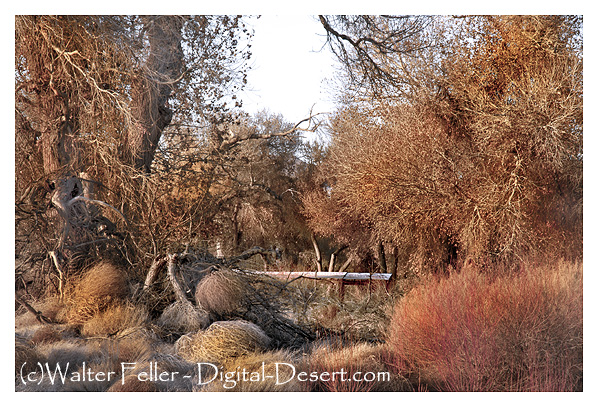Invasive Species

The spread of invasive exotic plants and animals has become an urgent environmental threat throughout California, second only to habitat loss as the cause of species endangerment. While many non-native plants are not harmful, the noxious weeds crowd out native plants, compete with natives for limited resources, lower productivity for agriculture and grazing, and alter fire regimes. The worst culprits in our desert ecosystems are tumbleweed or Russian thistle (Salsola tragus), cheatgrass (Bromus tectorum), Saharan mustard (Brassica tournefortii), giant reed (Arundo donax), and tamarisk or saltcedar (Tamarix ramosissima).
The latter two weeds have overtaken riparian zones along river channels, irrigation canals, and other wetland habitats, eliminating native species by outcompeting them for water, increasing soil salinity, and decreasing habitat values. A prime example of this can be seen at the Cibola National Wildlife Refuge along the Colorado River where native mesquite and willow have been almost totally supplanted by giant reed and tamarisk.
Saharan mustard is problematic in the Colorado Desert, especially in sensitive habitat areas such as washes and dunes in the Imperial Valley. In the Algodones Dunes, Saharan mustard is threatening several rare plant species (DoTomaso et al., 2007). Cheatgrass is mostly a problem in the Great Basin but extends into the California deserts. Its presence provides a continuous cover, allowing the spread of wildfires in ecosystems that have not evolved adaptations to frequent fires. Two other exotic grasses, Arabian grass (Schismus barbatus) and Mediterranean grass (Schismus arabicus), are also common desert weeds.
Invasive species are not the only threat to native plants of the California deserts. Other threats include suburban expansion, power generation, military training, off-highway vehicles, grazing, mining, and agriculture—the latter due to both land conversion and the lowering of the water table (Barbour et al., 1991). Global warming and climate change are also current and future threats over the next 100 years and beyond. Once damaged the desert, as a fragile ecosystem, is extremely slow to recover; natural revegetation can be measured in centuries (Carpenter et al).
At least for the present, there are many beautiful intact desert ecosystems for us to enjoy and study. Large tracts of desert land are protected as national and state parks, monuments, natural areas, and reserves. With their unique assemblages of plants, geomorphological diversity, rich history, and wide open spaces, the Mojave and Colorado deserts of California are waiting for us to explore, appreciate, and protect.
Previous - Next